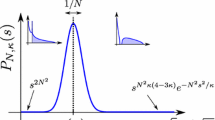Summary
In this paper bounds are derived for the effective permit tivity, ε*, using two standard variational principles. The principles are expressed in terms of the electric field,E and the electric displacement,D, respectively. As trial functions we use perturbation expansions forE andD that have been modified by the inclusion of a set of multiplicative constants. The first-order perturbation effect is calculated explicitly and the bounds for ε* are found in terms of expressions involving third-order correlation functions of the form\(\overline {\varepsilon ^\prime (0)\varepsilon ^\prime (r)\varepsilon ^\prime (s)} \) and\(\overline {\varepsilon ^\prime (r)\varepsilon ^\prime (s)/\varepsilon (0)} \) where ε′ is the fluctuating part of the permittivity. In the limit of small perturbations the bounds coincide and yield the result obtained by previous investigators.
Riassunto
Nel presente lavoro si ottengono i limiti per la permittività effettiva ε*, impiegando due principi variazionali convenzionali. Si esprimono i principi in termini, rispetti-vamente, del campo elettricoE, e dello spostamento elettrico,D. Come funzioni di prova usiamo sviluppi perturbativi diE eD modificati con l’inclusione di un gruppo di costanti multiplicative. L’effetto perturbativo del prim’ordine si calcola esplicitamente e i limiti di ε* si trovano in termini di espressioni che contengono funzioni di correlazione del terzo ordine aventi la forma\(\overline {\varepsilon ^\prime (0)\varepsilon ^\prime (r)\varepsilon ^\prime (s)} e \overline {\varepsilon ^\prime (r)\varepsilon ^\prime (s)/\varepsilon (0)} \) in cui ε′ è la parte fluttuante della permittività. Nei limiti delle piccole perturbazioni i limiti coincidono e forniscono i risultati già ottenuti da precedenti ricercatori.
Similar content being viewed by others
References
W. Brown: Private communication to Hashin and Shtrikman (1962).
Z. Hashin andS. Shtrikman:Journ. Appl. Phys.,33, 3125 (1962).
W. Brown:Journ. Chem. Phys.,23, 1514 (1955).
M. Beran andJ. Molyneux:Nuovo Cimento,30, 1406 (1963).
Author information
Authors and Affiliations
Additional information
This work was supported by the U. S. Army Research Office, Durham, N.C., Grant DA-ArO-D31-124-G-331.
Calculations have since been made for symmetric two-phase media and the results compared with other bounds that have been derived. In addition this formalism has been applied to the calculation of the effective bulk modulus for elastic materials. These results have been submitted for publication.
Rights and permissions
About this article
Cite this article
Beran, M. Use of the vibrational approach to determine bounds for the effective permittivity in random media. Nuovo Cim 38, 771–782 (1965). https://doi.org/10.1007/BF02748596
Received:
Published:
Issue Date:
DOI: https://doi.org/10.1007/BF02748596




